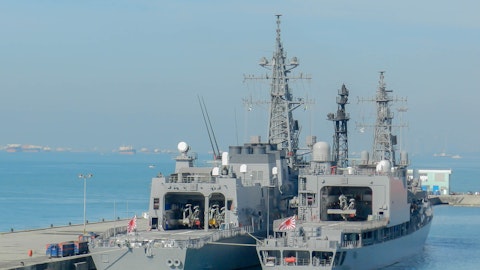Spirit AeroSystems Holdings, Inc. (NYSE:SPR) Q4 2023 Earnings Call Transcript February 6, 2024
Spirit AeroSystems Holdings, Inc. misses on earnings expectations. Reported EPS is $ EPS, expectations were $1.33. Spirit AeroSystems Holdings, Inc. isn’t one of the 30 most popular stocks among hedge funds at the end of the third quarter (see the details here).
Operator: Good morning, ladies and gentleman, and welcome to the Spirit AeroSystems Holdings, Inc. Fourth Quarter and Full Year 2023 Earnings Conference Call. My name is Prica and I’ll be the coordinator today. [Operator Instructions] I would now like to turn the presentation over to Ryan Avey, Senior Director of Investor Relations and FP&A. Please go ahead.
Ryan Avey: Thank you, and good morning, everyone. I’m Ryan Avey. With me today are Spirit’s President and Chief Executive Officer, Pat Shanahan; and Senior Vice President and Chief Financial Officer, Mark Suchinski. Before we begin, I need to remind you that, any projections or goals we may include in our discussion today are likely to involve risks, including those detailed in our earnings release, in our SEC filings and in the forward-looking statement at the end of this web presentation. In addition, we refer you to our earnings release and presentation for disclosures and reconciliation of non-GAAP measures we use when discussing our results. With that, I’d like to turn the call over to Pat.
Pat Shanahan: Thank you, Ryan, and good morning, everyone. Today, I will update you on how we are running the business at Spirit. Most of my remarks will focus on the steps we took after the January 5th accident. Mark will address the financials in his comments. My mandate, when I came here was to put our operations and financials back on solid footing. In my estimation, we achieved significant progress toward that goal in the fourth quarter. However, the accident on January 5th demanded a different focus by our team. Consistent with our protocols, our response team was activated within hours. Since that moment, Spirit’s focus was on supporting Boeing, its airline customers, the NTSB, the FAA and our people. The immediate response was taking a hard look at our processes and incorporating any findings into action.
Within days, we enacted countermeasures to include adding inline and ship in place inspections with Boeing that replicated those performed by the airlines to return to service, leveraging the FAA’s safety management system to conduct a product safety risk assessment. Incorporation of detailed review and observation with Boeing of the mid entry door plug assembly and installation process to include both Spirit and Boeing operations. Concurrent with those immediate actions, we have initiated a second wave of actions centered on addressing human factors, nonconformities, product safety, and expanded inspections across 737 manufacturing. People are at the heart of the company and our manufacturing processes. A significant portion of the 737 fuselage build is manually performed by our skilled teammates.
Repeatability, reliability and capability in manufacturing is required to produce high quality conforming products. The human condition and human factors must be accounted for in any improvement efforts. And through that lens, we are focusing additional actions. The four main levers to mitigate human factors that we are pulling include proficiency of our mechanics and inspectors. Compliance to our quality management system, mistake proofing and observation. We will do more testing and training. We will drive greater discipline to the QMS. We will enable our teammates with better tools, techniques, and technology that is available today. The goal of any world-class manufacturing company is perfection or zero defects. We aspire to achieve perfection, detecting, correcting, and ultimately preventing defects, otherwise known as nonconformities is the basis for continuous improvement.
We are expanding our efforts to integrate more with Boeing’s QMS realigning organizationally to accelerate redesign and process re-engineering and utilizing more advanced data analytics. We are also increasing the number of spirit performed inspections and Boeing performed inspections, and soon we will integrate these efforts with those of the FAA and customers who have joined us here in Wichita. That is a brief summary of some of the systemic improvements in our second wave of collective actions. There are additional actions we are taking as well. The point is we are mobilized for implementation with detailed plans and fully aligned with Boeing. Our next wave of improvement will be the deployment of autonomation and automation for sections of the airplane that remain highly manual.
That is the fundamental solution to zero defects and zero escapes. On the 737 fuselage, the front and back sections have the most complex physical geometries and are the most confined workspaces. The build is largely manual. Our eye is toward finding the right balance of using human assisted technology and automated technology. There is a path to deployment. Broadly speaking, full scale robotics is impractical. In our research labs, we have significant human assisted technology that is manufacturing readiness level six that we look to accelerate. I have recently reviewed this technology with the team and will ensure it receives the appropriate resources and investments. I’m very proud of how our team has responded to this accident. They have been calm, focused and moving with urgency.
I have a lot of confidence in this team. At this point, the art form is to integrate broad actions with our ongoing operations and not as a one-off project. Our teams across manufacturing and engineering are fully aligned and will implement changes seamlessly. I believe we will move quickly because of our shift in governance away from being top down. The mindset shift is to understand that the airplane is the boss. The airplane tells us what to do. Our mechanics, sealers, engineers and inspectors are like surgeons. They tell us in management what they need to perform their operations. Our goal is to give them what they need, when they need it, and resolve issues or make improvements. Receptivity from our teammates across our facilities, shop floors and offices has been positive.
I also appreciate their candor and telling me what’s on their minds. I’ve heard from every corner of the factory in Wichita and from every shift. Lots of energy, lots of ideas. This does not surprise me. Our workforce at Spirit has a clear understanding of the importance of their work. That commitment is rooted in a long legacy we have in this industry. In the coming weeks, we’ll learn more from the regulators from their formal reporting, and we’ll respond with urgency and transparency. Now, I’ll shift to a couple other topics I think you have on your mind as well. First, we made significant progress in the fourth quarter in stabilizing the 737 production line. We briefly paused the line to stabilize, which ultimately allowed us to deliver 104 fuselages.
The highest quarterly total in four years. We made investments during the quarter to recover schedule and buffer the production system, which enabled us to start the year with a balanced factory. Second, we recognize additional forward losses on the A350 and A220 programs this quarter, which Mark will address in a moment. That said, we are working to not only improve these programs in our day-to-day operations, but also are engaged in discussions with Airbus to address the long-term financials. The negotiations with Airbus continue and have been productive. We hope to conclude by February, but we need to ensure all items are addressed. We are converging on operational and financial solutions. I appreciate the partnership and engagement by their leadership.

This remains an important near term priority for me. I’ll now turn the call over to Mark to review with you our financial results.
Mark Suchinski: Thanks, Pat, and good morning everyone. We experienced significant pressures in 2023 due to production schedule volatility, supply chain constraints, and ongoing inflation, quality challenges and increased labor costs. This resulted in higher than anticipated costs throughout the year. However, we also accomplished some major milestones during the year, including reaching a contractual resolution with our largest union, bringing Pat on board to lead Spirit’s recovery, and executing a favorable agreement with our largest customer. We also did a debt refinance and a capital raise, which strengthened our capital structure and increased production rates across many of our major programs. While we expect some of these pressures from 2023 to continue into 2024.
We enter the year strongly focused on execution to stabilize and strengthen Spirit, both operationally and financially. Given the latest news around the 737 MAX production rates in relation to the FAA approval, as well as our ongoing negotiations with Airbus, we are not in a position to provide guidance at this time. Now, let me take you through the details of our fourth quarter financial results. Let’s start on Slide 2. Revenues for the quarter were $1.8 billion, up 37% from the fourth quarter of 2022. This substantial increase year-over-year was primarily due to higher production on our commercial programs, increased Defense and Space and aftermarket segment revenues, as well as the impacts from the previously disclosed Boeing MOA executed in October of 2023, which included favorable pricing adjustments on the 787 program.
Overall, deliveries in the quarter increased 16% year-over-year. Now turning our attention to EPS. We have reported earnings per share of positive $0.52 compared to negative $2.32 in the fourth quarter of 2022. Excluding certain items, adjusted EPS was $0.48 compared to negative $1.46 in the prior year. Operating margin was positive 11%, compared to negative 11% in the same period of 2022, largely driven by the favorable impacts from our Boeing MOA. As a result of the favorable pricing adjustments to the 787, we reversed $361 million of total liabilities during the fourth quarter, which included 787 forward loss reversals of $206 million which favorably reduced cost of sales and reversal of 787 material right obligation of $155 million which flowed through the income statement, as an increase to revenue.
Fourth quarter net forward loss reversals totaled $34 million and unfavorable cumulative catch-up adjustments were $55 million. This compared to $114 million of forward losses and $59 million of unfavorable cumulative catch-up adjustments in the fourth quarter of 2022. The current quarter forward losses relate primarily to A350 and A220 programs and were driven by higher estimates of supply chain, labor and other costs. We also recorded net incremental forward losses for anticipated performance obligations beyond 2025 in the amount of approximately $30 million. The unfavorable cumulative catch-up adjustments relate primarily to 737 program, reflecting higher costs required to recover and stabilize the production system, which we have done in the fourth quarter.
Now turning to free cash flow. Free cash flow for the quarter was positive $42 million, compared to free cash flow usage of $66 million in the fourth quarter of 2022. Fourth quarter free cash flow includes the previously disclosed funding of approximately $100 million received from Boeing per the terms of the MOA and tooling and capital through 2025 on both the 737 and 787 programs. In our effort to stabilize operations, we also made certain working capital investments and accelerated certain capital investments in the fourth quarter of 2023. Now let’s discuss our quarterly segment performance starting with our commercial segment on Slide 3. In the fourth quarter of 2023, commercial revenues increased 43% over the same period in 2022 due to higher production across all of our programs, as well as favorable pricing from the 787 Boeing MOA.
Quarterly operating margin increased the positive 17%, compared to negative 8% in the prior year, primarily driven by favorable change in estimates recorded in the current period. These changes in estimates, which I previously disclosed included net forward loss reversals of $48 million and on favorable cumulative catch-up adjustments of $51 million. In comparison to the fourth quarter of 2022, the segment recorded charges of $111 million of forward losses and $58 million of unfavorable cumulative catch-up adjustments. Now let’s turn to Defense and Space segment on Slide 4. Defense and Space grew to $205 million, up 12% higher than the fourth quarter of last year due to higher development program activity and increased KC-46 tanker production.
Operating margin for the quarter decreased to 2% compared to 11% in 2022, primarily due to higher unfavorable changes in estimates recorded in the period. The segment recorded forward losses of $13 million and unfavorable cumulative catchup adjustments of $4 million compared to forward losses of $2 million in the fourth quarter of 2022. The forward losses were primarily driven by higher production cost estimates on the CH-53K program and unfavorable cumulative catch-up adjustments, which were primarily driven by the Boeing P-8 program. For our aftermarket results, let’s turn to Slide 5. Aftermarket had a strong quarter with revenue of $91 million, up 24% compared to the fourth quarter of 2022, primarily due to higher spare part sales. Aftermarket has continued to grow with global aircraft recovery and is on-track to meet our plan for $500 million by 2025.
Operating margin was strong for the quarter at 23% compared to 13% during the same period of 2022, primarily due to the absence of a 1x inventory adjustment charge recognized in the fourth quarter of 2022. With that, let’s now briefly touch on our full year results on Slide 6. 2023 revenue came in at $6 billion, that’s up 20% year-over-year driven by higher commercial production volumes as well as higher defense and space and aftermarket segment revenues. 2023 adjusted EPS decreased year-over-year, primarily due to higher interest and other expenses partially offset by improved operating income during the current year. Other expense for 2023 was $140 million compared to other expenses of $14 million in 2022, primarily due to higher non-cash losses related to settlement accounting for our primary U.S. pension plan, foreign currency, and sales of receivables were recognized in 2023.
Full year cash flow was a usage of $374 million compared to a use of $516 million in 2022. Free cash flow usage was higher than we previously expected, primarily due to factory costs incurred in the quarter to recover, schedule, and stabilize operations, higher levels of inventory to support rate increases as well as increased CapEx spend related to the customer funded capital and tooling received as part of the Boeing MOA. With that, let’s now turn to cash and debt balances on Slide 7. We ended the year with $824 million of cash, which reflects the proceeds from the issuance of common stock and exchangeable senior notes during the fourth quarter of ‘23. We will use the if converted method regarding exchangeable notes, implications to EPS, which results in the shares being dilutive if there is positive net income.
If net loss position, they would be anti-dilutive. We ended a year with $4.1 billion of debt. There are now no significant debt maturities until 2026. So with that, we will be happy to take your questions.
See also Top 20 Most Innovative Economies in Asia and 15 Highest Quality Grocery Stores In The US.
Q&A Session
Follow Spirit Aerosystems Holdings Inc. (NYSE:SPR)
Follow Spirit Aerosystems Holdings Inc. (NYSE:SPR)
Receive real-time insider trading and news alerts
Operator: [Operator Instructions] We have the first question on the phone lines from Seth Seifman of JPMorgan.
Seth Seifman: Pat, thanks very much for the comments at the beginning of the call. I guess maybe to level set a bit where 737 is right now. You talked about stabilizing the factory in the fourth quarter. Does that mean stabilizing at a production of 38 a month? And if we took it as a given that it’s up to the FAA now when that rate will move higher, but if we took it as a given that, that’s the rate for 2024, that Spirit is now in a place to produce at that rate through the year. And that what we saw – what we’ve read about over the past few weeks since the Alaska accident and specifically, yesterday with the latest mis-drilling issues and, and Boeing’s effort to cut down on traveled work. Do you still kind of consider the factory to be stabilized at 38 a month?
Pat Shanahan : Seth, I would tell you that we are cycling at 42 a month but building at 38 a month. And by that, I mean we have a production schedule that allows us to have buffer days, and it’s our means of testing our ability to go up in rate. And that buffer — those buffer days allow the factory to when we talk about stability, minimized traveled work, have everybody stay in position. So from that standpoint, we’re in a good position, and we’ll take our guidance from Boeing as to how to adjust our schedules if necessary. Maybe I’ll just address those two nonconforming holes, those are not a safety of flight issue, and just kind of characterize the normal process. Anytime there’s a nonconformity, we basically scope and bound it engineering does a preliminary look to see if there’s a safety of flight issue, then essentially, we communicate to the customers if there’s any potential exposure, but we say, here’s a heads up and then we do a detailed engineering analysis and work to get a final disposition when we have a final disposition that we can determine and repair and from that a response.
And relative to these two holes, there is not a final engineering disposition. We expect that in the next 72 hours. Based on that, we’ll determine what the repair might be and any impact associated with that. And then the follow-on is a root-cause corrective action.
Operator: We now have David Strauss of Barclays.
David Strauss: Quick follow-up there. What is the status of the MAX buffer stock as it relates to you matching up with Boeing in terms of your production rate? And then on the Airbus side of things, the $5 million mark us on the balance sheet. At this point, is that really all A220 A350 negotiates to conclude with Airbus, should we expect to see a significant reversal there?
Mark Suchinski: Sure. David, let me address your second comment in regards to the balance sheet and the forward loss reserves that we have, both short-term and long-term. I think we met — we mentioned this on the last call as it relates to Boeing and the 787 program, we stated that we would be in a forward loss through ’24, maybe slightly into the first quarter of 2025. So really the short-term forward loss is — has some 787 in there as we come down our unit cost curves and drive that to cash flow positive in 2025 and then it would include the A350 as you indicated in A220 and a little bit on 67 and CH-53K, but I think you got it right.
Pat Shanahan : Maybe just to answer the question about the buffer or what we refer to as the ship in place, there are 42 available units today to ship in place. We’re taking a few extra days. So think of that as a delay on some of the deliveries to rented just to make sure we can complete all the inspections related to the mid-entry door plug as well as any known rework and doing — conducting some additional inspections.
Operator: We now have Jason Gursky of Citigroup.
Jason Gursky: Maybe a two part question. I apologize for that. Patrick wonder if you can just — to fix the problem, you have to understand exactly how you got here. So I was wondering if you could just from your perspective, describe a little bit about the conditions that led us to where we are today. It sounds like you’ve got a plan to fix something. I’m just kind of curious to get your input on how we got here. And then the second part of the question is, once we figure this all out, has anything kind of fundamentally changed on the types of rate breaks that you can do in the future? I know Boeing’s got a master schedule out there. And historically, you guys have gone up 10%, 15% on different rate breaks and then hold for a bit before going back up again.
So I’m just wondering, in the context of all of this, whether things have fundamentally changed in the industry or the industry’s view on its ability to go up in rate and whether we go up slower than we have in the past.
Pat Shanahan : Yes, Jason, I think it’s hard to go back and look at how we got here. I wish I had that history. But what I would tell you is the basic fundamentals around rate breaks haven’t changed. Some of the dynamics around the supply chain have changed. I would offer that some of the work that Spirit has done in the fourth quarter to align the 2024 plan with Boeing’s rate schedule has afforded us some more stability. We have used that time to improve the dynamics of the supply chain. We’ve seen a lot of improvement in the near term to support rate 42. As it relates to rate 47, we have line of sight on virtually all the issues. Suppliers that we have to give special attention to. But at this point, the majority of the issues are related to raw material and labor availability.
I think the hardest part of this industry is given its complexity and breadth, how do you judge how quickly to go up in rate. In the case of the 737, it’s been done before. So there’s a playbook that parametrically says — this is what you can do, but we have to adjust that for current events in the environment. But I would say that the 2024 plan we laid out is — incorporates the existing environment. And if there are any changes, we’ll accommodate Boeing’s direction.
Operator: We now have Myles Walton of Wolf Research.
Myles Walton: Pat, you’re in a pretty unique position having been inside of Boeing Vice President of Commercial Airplanes for time and now inside of Spirit. And I can sort of give the perspective, I think, of what if and the what if is — if Wichita, we’re still part of Boeing with the signals with the Boeing quality, the QMS system have captured these quality escapes sooner? And if so, does that create industrial logic for some element of reabsorption? Or is the solution just a greater integration into Boeing’s existing QMS?
Pat Shanahan : I guess I would respond not so much to the hypothetical, but the fact that we’re behaving as if we were part of Boeing and that the coordination and the integration you refer to is really taking place now. So if you sat in one of our meetings, you people took off their badges, you would not be able to tell which company they worked for. I think because of the trust that’s been built recently, some of the feedback loops that existed in the past are being restored and that should allow us to even work better together.
Myles Walton: So just to clarify that, Pat, is that a change of behavior, the tightness of the feedback loop? Or is that a reflection of what’s always been the case?
Pat Shanahan : I would — I think as a result of the MOA and the shedding of the financial constraints, it opened up the aperture to really work more seamlessly together, and we’re seeing that. And I think we’re surprised every single day how much more quickly people are working shoulder to shoulder. So I think the MOA was a big change that allowed us to increase the integration between the two companies.
Operator: We now have Sheila Kahyaoglu from Jeffries.
Sheila Kahyaoglu: Pat, if I could ask you in just its current state, how do we think about the 737 cash profile per ship set, just given potentially additional costs this year how does that change with the rate break in ’25 the FAA does also limit you guys at 38% a cap? I’m not sure. And then into ’26, the free cash flow per shipset, just given the step down? Just pass profile.
Pat Shanahan : Sheila, I’m just trying to think. Yes. No, no, no. I mean we obviously go up in rates, you can distribute the overhead more broadly. The fundamentals of the things that we’re doing in terms of improving cash flow or cost reduction and a lot of that’s through productivity or improvement in quality. So those things aren’t going to change. We’ve built a plan around achieving support labor support, I’ll say, cost that mirrors our performance in 2018. We’re working to that regardless of a change in direction from Boeing. So that might dampen a bit. Indirect costs, we’re going after the same way, probably the one that wouldn’t be affected by rate as working capital because we just need to optimize that to a much larger degree last year, we were anticipating being at a much higher rate. So there’s a real opportunity there regardless of where the rates stabilize that. Mark, do you have any other comments?





